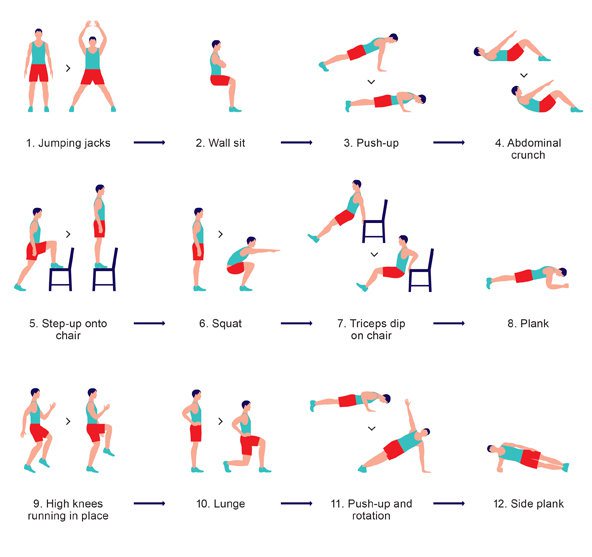Exercise in 7 minutes or less
Does the thought of hours at the gym fill you with horror?
You are not alone – and, you are in the majority.
Fortunately research over the last few years is showing that we don’t all have to sweat it out for hours and hours.
How Exercise Can Help
If you at a huge high-fat meal for breakfast, there will be plenty of fat floating around your bloodstream in the hours following the meal.
BUT: If, in the previous 12 or so hours you engaged in some exercise the outcome is different. Science shows us that there will be a whole lot less fat floating around waiting to be stored somewhere.
Exercise kicks your body into action.
Traditional Exercise Guidelines Are Wrong
Health authorities (such as the CDC) recommend about 150 minutes of moderate intensity per week.
The reality: About 80% of us don’t do this.
What’s even more depressing is that we all respond very differently. About 20% of us are super-responders: If we do this exercise we will rapidly get fitter, burn fat, and get stronger.
But for many of us, the outcomes are far from dramatic. All that hard work – and hardly any outcome.
The New Research on Exercise
The good news is: very short amounts of exercise can have just as much benefit as much longer workouts.
High Intensity workouts go like this:
- 30 seconds of an exercise as fast and hard as you can.
- 10 seconds rest.
- Repeat 3+ times.
This exercise protocol can bring as many gains as much longer workouts.
In 2013, the ACSM came up with a “7 Minute workout”. Using body weight alone (no special equipment), this trained all major muscle groups. Their article reviewed all the research on High Intensity training and created an ideal workout. The NY Times explained it further.
Do each of these exercises for 30 seconds, and then rest for 10 seconds after each exercise (total: 7 minutes).

The health benefits are numerous: increase in subcutaneous fat loss, strength development, increased VO2 max (your body’s efficiency at using oxygen), improved insulin sensitivity (your body is much better at dealing with sugar).
Note: If you are a beginner, you should consult a medical professional before attempting any high intensity training.
See more workout plans and fitness programs.
- Bond, B. J., Perry, A. C., Parker, L., Robinson, A., & Burnett, K. (2002). Dose-response effect of walking exercise on weight loss. How much is enough?. International journal of obesity and related metabolic disorders: journal of the International Association for the Study of Obesity, 26(11), 1484-149 .Link
- Burgomaster, K. A., Howarth, K. R., Phillips, S. M., Rakobowchuk, M., MacDonald, M. J., McGee, S. L., & Gibala, M. J. (2008). Similar metabolic adaptations during exercise after low volume sprint interval and traditional endurance training in humans. The Journal of physiology, 586(1), 151-160. Link
- Talanian, J. L., Galloway, S. D., Heigenhauser, G. J., Bonen, A., & Spriet, L. L. (2007). Two weeks of high-intensity aerobic interval training increases the capacity for fat oxidation during exercise in women. Journal of applied physiology, 102(4), 1439-1447. Link